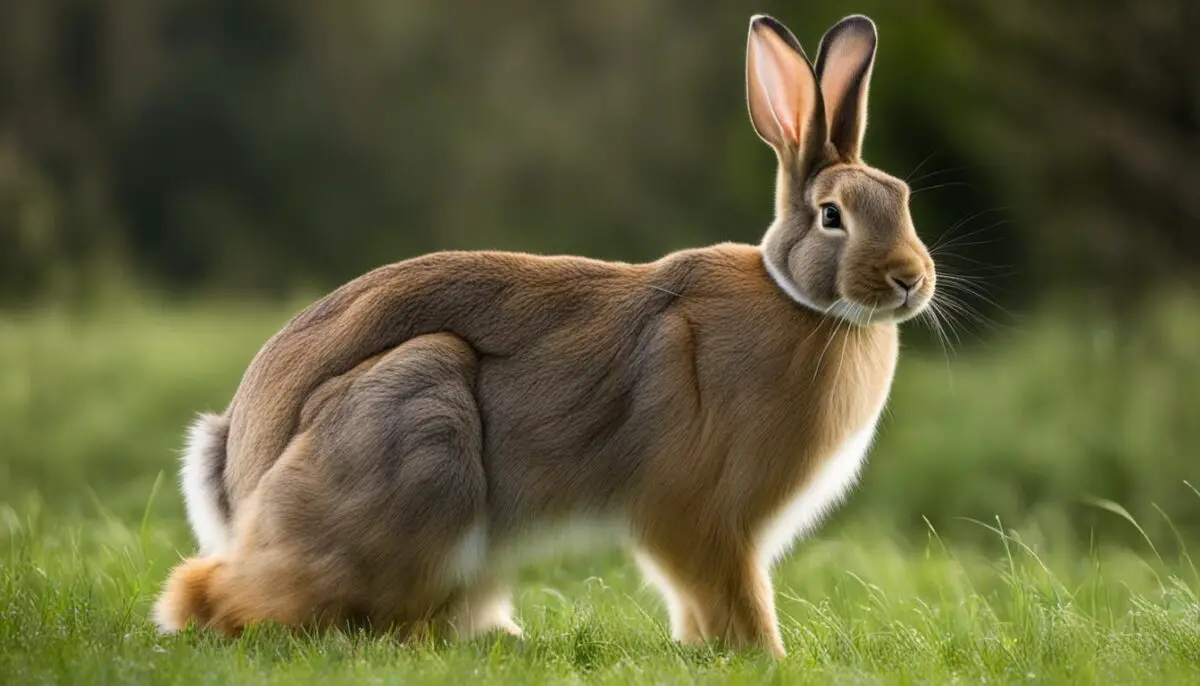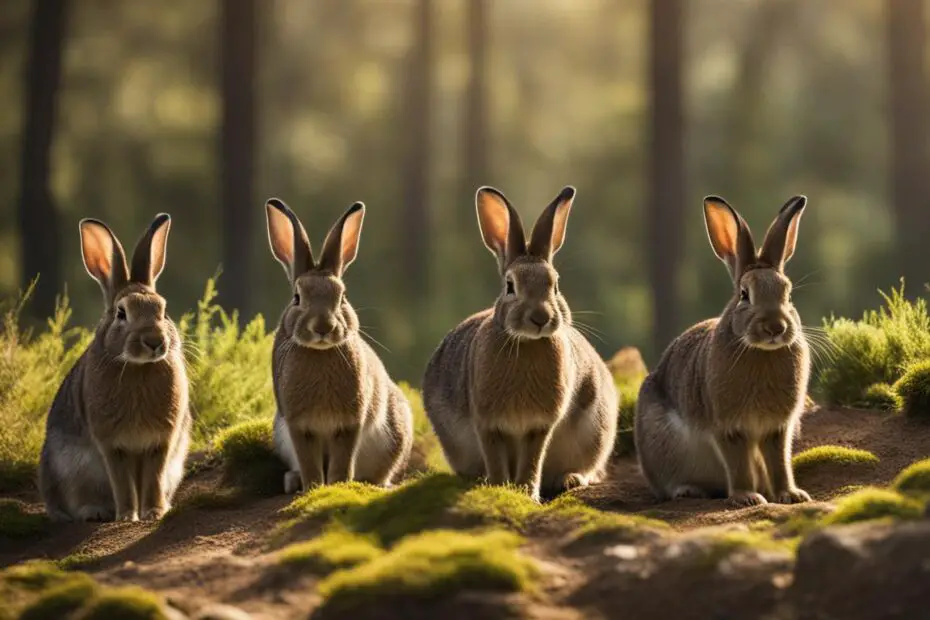Large wild rabbits, also known as wild rabbit breeds, are captivating creatures that have fascinated people throughout history. One of the most remarkable species in this category is the Flemish Giant. These giant wild rabbits can weigh an average of 15 pounds and reach an impressive length of 2.5 feet. With their thick, glossy fur and a variety of colors, they truly command attention.
The Flemish Giant is not just a remarkable wild rabbit species; it is also an ancient breed of domesticated rabbit that originated in Belgium during the 16th century. This breed made its way to North America in the 1890s, and since then, it has become a stable and popular breed in the region. Flemish Giants are known for their versatility, being bred not only for their meat and fur but also as affectionate companion animals.
Key Takeaways:
- The Flemish Giant is one of the largest wild rabbit breeds, weighing around 15 pounds and measuring up to 2.5 feet in length.
- Originating in Belgium during the 16th century, the Flemish Giant was introduced to North America in the 1890s.
- These rabbits have a docile and gentle temperament, making them well-suited as companion animals, especially for children.
- Flemish Giants have a thick, glossy fur and come in a variety of colors, making them visually striking.
- Despite their size, Flemish Giants can be easily trained and litter-box trained, allowing them to roam freely indoors.
The Physical Characteristics of Large Wild Rabbits
Large wild rabbits, such as the Flemish Giant, possess unique physical traits that set them apart. Their large and nicely shaped head is a prominent feature, with males having broader heads compared to females. Females have a dewlap, a large fold of skin under the chin that they use to warm their young. This not only showcases their maternal instincts but also adds to their distinctive appearance.
The Flemish Giant boasts a long and powerful body, which contributes to its imposing size. Their evenly colored coats, available in seven officially recognized colors including black, blue, fawn, and white, further enhance their visual appeal. However, it is their thick, glossy fur that truly makes them stand out. This lustrous coat adds to their overall magnificence and reflects their evolved adaptation to different environmental conditions.
When encountering a Flemish Giant, one cannot help but be captivated by its majestic presence and beautiful appearance. These rabbits embody the epitome of a well-bred and preserved breed, with their physical features perfectly demonstrating their unique characteristics.
Distinct Physical Characteristics of the Flemish Giant:
- Large and nicely shaped head
- Dewlap in females, used for warming their young
- Long and powerful body
- Evenly colored coat
- Thick, glossy fur
In addition to their physical characteristics, the Flemish Giant’s temperament and behavior make them even more remarkable. Known for their gentle nature and adaptability, these rabbits are not only extraordinary in appearance but also make excellent companion animals. Whether as show rabbits or cherished pets, Flemish Giants continue to be appreciated for their impressive physical attributes and lovable personalities.

The Origins and Introduction of Large Wild Rabbits in North America
Large wild rabbits like the Flemish Giant have a fascinating history that dates back centuries. Originating in Belgium, these rabbits were initially bred for their meat and fur, and the breed has been in existence since the 16th century. The first breed standards for Flemish Giants were established in 1893, solidifying their reputation as a distinct domesticated rabbit breed.
In the 1890s, Flemish Giants were introduced to North America through imports from both England and Belgium. This marked the beginning of their journey on the continent, where they quickly gained popularity not only for their practical uses but also as companion animals and show rabbits.
Over time, Flemish Giants have successfully adapted to domestication, becoming known as the “Gentle Giants” of the rabbit world. Their large size, calm temperament, and gentle nature have made them beloved by rabbit enthusiasts, families, and breeders alike.
“Flemish Giants have a rich history that spans centuries and continents. Their origins in Belgium and their introduction to North America have shaped their reputation as impressive and lovable companions.”
Today, Flemish Giants continue to be cherished and recognized for their unique qualities. They are admired for their calm demeanor, affectionate personality, and versatility as both pets and exhibition rabbits. Their popularity as a breed has remained stable, reflecting their desirability and compatibility with various lifestyles.
To further illustrate the incredible journey and characteristics of Flemish Giants, take a look at the table below:
| Characteristics | Description |
|---|---|
| Origin | Belgium in the 16th century |
| Introduced to North America | 1890s, through imports from England and Belgium |
| Main Uses | Meat, fur, companion animals, and show rabbits |
| Temperament | Gentle, calm, and docile |
| Physical Traits | Large size, thick fur, variety of coat colors |
| Nickname | “Gentle Giants” |
The Unique Traits and Current Status of Large Wild Rabbits
What sets large wild rabbits like the Flemish Giant apart are their unique traits. Despite their size, these rabbits possess excellent hearing and good eyesight, which they inherited from their wild rabbit ancestors. It is these exceptional sensory abilities that contribute to their survival in the wild.
Besides their distinctive physical characteristics, large wild rabbits also have a gentle temperament, making them ideal as companion animals. Despite their imposing stature, they are known for their docility, especially with children. Their gentle nature creates a sense of trust and comfort, making them beloved pets among families.
The Flemish Giant, in particular, stands out as a stable and popular breed today. Unlike many other domesticated animal breeds that have suffered from over-breeding or over-harvesting, Flemish Giants have maintained their integrity throughout history. This is a testament to the responsible breeding practices and the breed’s popularity, ensuring their continued existence and well-being.
Attributes of Large Wild Rabbits:
- Excellent hearing and good eyesight
- Gentle temperament
- Highly adaptable
- Ability to be easily trained
Many people appreciate the docile and friendly nature of Flemish Giants, further contributing to their popularity. In addition to being companion animals, they are often bred for show competitions, showcasing their impressive size and remarkable presence. The breed’s widespread recognition and admiration in both the pet and show rabbit communities reinforce their position as a truly exceptional and noteworthy breed.
It is important to preserve and appreciate the unique traits of large wild rabbits like the Flemish Giant. Their distinctive attributes and gentle temperament make them a sought-after choice for families and individuals looking for a companion that stands out from the crowd. This popularity ensures their continued presence and recognition in the world of rabbits.
Conclusion
When it comes to large wild rabbits, the Flemish Giant is truly remarkable. These rabbits captivate with their impressive size, unique physical characteristics, and gentle temperament. They have become a popular choice for both meat and fur production as well as companionship.
Despite being domesticated, Flemish Giants still possess certain traits inherited from their wild rabbit ancestors. Their excellent hearing and sharp eyesight are remnants of their natural instincts. Additionally, these adaptable creatures can be easily trained to roam indoors, showcasing their versatility as companion animals.
The Flemish Giant serves as a testament to the rich diversity and wonder of the world’s largest rabbit species. With their striking appearance, gentle demeanor, and remarkable adaptability, these rabbits have found a special place in the hearts of people around the globe.
FAQ
What are some popular breeds of large wild rabbits?
One popular breed of large wild rabbits is the Flemish Giant.
How big can large wild rabbits get?
Large wild rabbits, such as the Flemish Giant, can reach an average weight of 15 pounds and a length of 2.5 feet.
Where do large wild rabbits originate from?
The Flemish Giant breed of large wild rabbits originated in Belgium in the 16th century.
When were large wild rabbits first introduced to North America?
Large wild rabbits, including the Flemish Giant, were first imported into the United States in the 1890s.
What are some unique traits of large wild rabbits?
Despite their size, large wild rabbits like the Flemish Giant have excellent hearing and good eyesight, traits inherited from their wild rabbit ancestors. They also have a gentle temperament, making them suitable as companion animals.
Are large wild rabbit breeds stable and popular today?
Yes, breeds like the Flemish Giant are stable and popular today for their meat and fur production, as well as for their gentle nature and suitability as companion animals.


